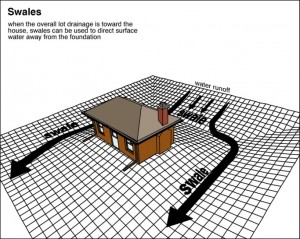 What is the purpose of a drainage swale and when do we use it?
What is the purpose of a drainage swale and when do we use it?
MN realtors and homeowners, you have been waiting patiently for the description of a drainage swale. So here it is! A drainage swale is a depression in the ground designed to direct water flow. You may have found one accidentally on a country road where a depression has been made to drain water from one side of the road to the other. Sometimes, in order to avoid this dip or depression in the road surface, a pipe is placed underneath the road so water can more easily flow through it. This underground pipe and manhole is called a culvert.
Swales are very effective at directing water flow away from the house. Imagine if your house was on a sloping lot with the house being part way up the slope and the water flowing down the hill toward the house. A swale could be installed, by creating a perpendicular depression, at a point above the house to deflect flowing water around the house. Then, it is directed into a culvert or a second swale taking all the water from the hill to the street drain. Swales may also be bermed on the lower side to direct flow and carry more water.
Berm… swale, culvert, berm… what strange words! The swale is a strategic depression in the ground that directs water flow and a berm is a man-made rise in the ground that achieves the same thing. An example of a berm would be levees that are used to contain flooding rivers.
 Previously, I stated that we could use a swale in places where we could not create 6 inches of fall, in the grade, in the first 10 feet sloping away from the foundation of the house. Imagine if the boundary line of your house was within 5 feet of the foundation and there was only 2 inches in slope to the boundary; you would not be able to achieve the code required 6 inches ground slope in the first 10 feet of fall. This could be achieved by digging a 4 inch deep swale perpendicular to the foundation, with 2% fall to the road drain. Water would flow freely to the road and away from the home foundation.
Previously, I stated that we could use a swale in places where we could not create 6 inches of fall, in the grade, in the first 10 feet sloping away from the foundation of the house. Imagine if the boundary line of your house was within 5 feet of the foundation and there was only 2 inches in slope to the boundary; you would not be able to achieve the code required 6 inches ground slope in the first 10 feet of fall. This could be achieved by digging a 4 inch deep swale perpendicular to the foundation, with 2% fall to the road drain. Water would flow freely to the road and away from the home foundation.
What is the purpose of the swale? Home inspectors know and now you do too!
Doug Hastings
MN Home Inspector, Minneapolis & St. Paul
Kaplan University, Home Inspection Lead Instructor
Rob ‘Pops’ Leslie
Kaplan Professionals, Retired



